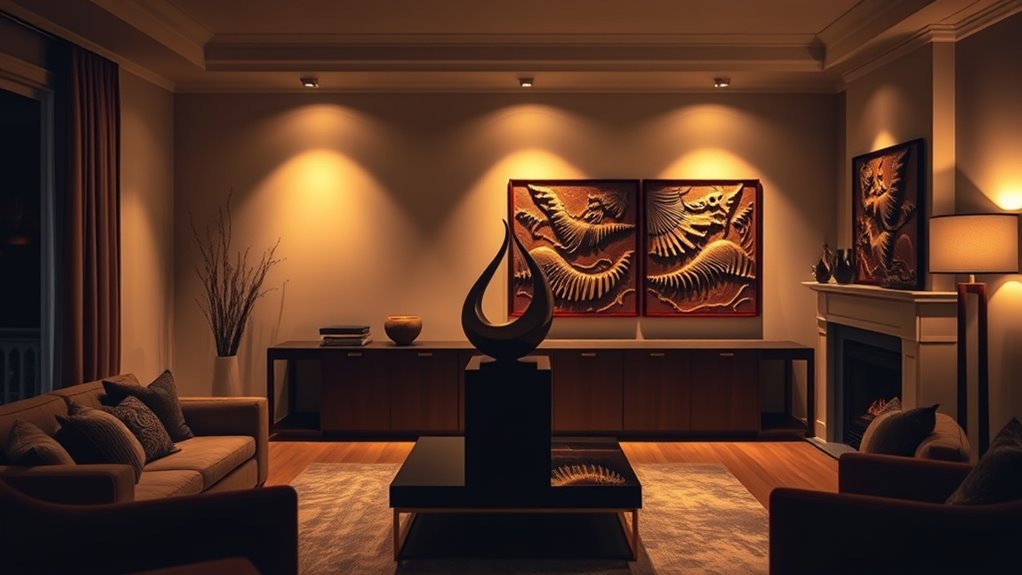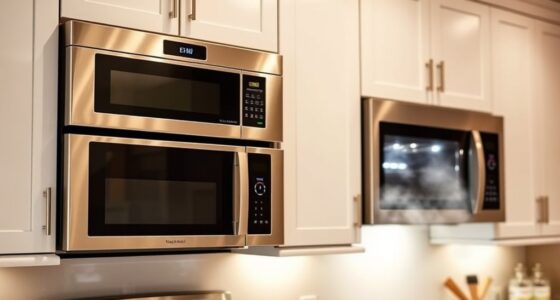To make the most of accent lighting, focus on highlighting key features without overdoing it. Keep fixtures at the right distance and angle to avoid glare and uneven coverage. Use adjustable and dimmable lights to control brightness and mood. Be cautious not to overuse spotlights, which can create harsh shadows and glare. Balancing different lighting layers and choosing fixtures that match your style will help create an inviting, cohesive space. Learn more to master your lighting design effectively.
Key Takeaways
- Properly position accent lights at about 30° angle and 1.5-3 times the feature’s size to avoid glare and uneven coverage.
- Use adjustable fixtures like spotlights or track lighting for flexible highlighting and precise control.
- Avoid overusing spotlights to prevent harsh shadows, glare, and increased energy costs.
- Incorporate layered lighting with dimmers to create a balanced and inviting ambiance.
- Match fixture style and placement to highlight artwork, architectural details, or textured features effectively.
Understanding the Role of Accent Lighting
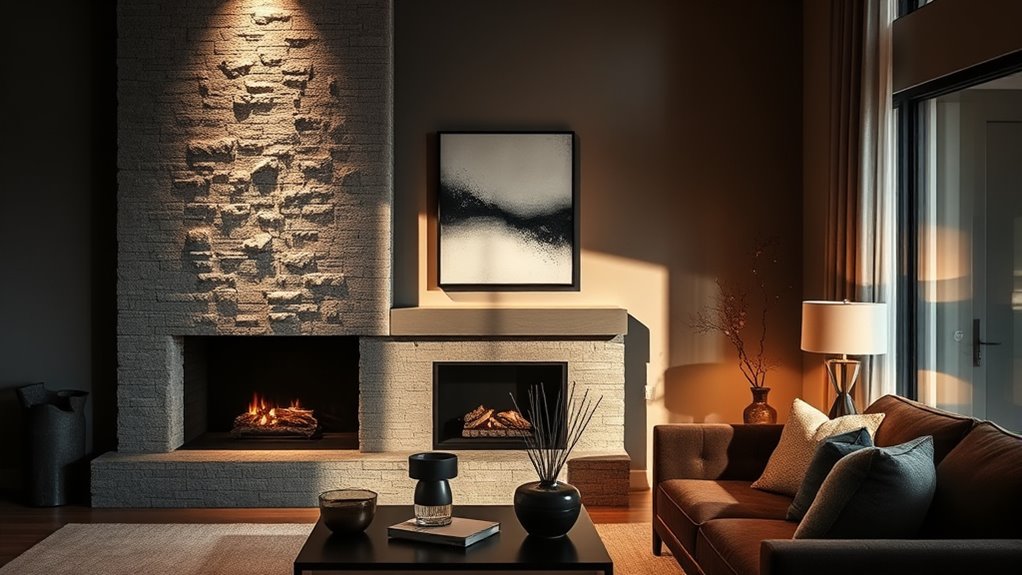
Understanding the role of accent lighting is essential because it helps you highlight specific features and create visual interest in your home. Accent lighting focuses a spotlight on focal points, drawing attention to artwork, architectural details, or decorative objects. By emphasizing these elements, you add depth and dimension, making your space more dynamic. Proper accent lighting enhances the overall ambiance while complementing ambient and task lighting. Fixtures like spotlights, sconces, and picture lights are designed to direct light precisely where you want it. When used thoughtfully, accent lighting not only highlights key features but also helps establish mood and style in a room. Additionally, understanding the distinction between interior design and decorating ensures that accent lighting is integrated effectively within a well-planned space involving technical knowledge. Recognizing support hours for assistance can help ensure your lighting setup aligns with your schedule and needs. Moreover, considering individual responses to lighting can help tailor the ambiance to suit different preferences and occasions. Proper placement and lighting balance are crucial for achieving the desired visual effects without overwhelming the space. Achieving this balance often requires understanding the principles of lighting hierarchy to create a harmonious environment. Ultimately, it’s a powerful tool for transforming ordinary spaces into visually engaging environments.
Key Principles for Effective Accent Placement

Effective accent placement hinges on positioning your lights to highlight features without causing glare or uneven illumination. Use accent lights at about a 30° angle above artwork or focal points to create natural highlights and minimize glare. Adjustable fixtures like spotlights or track lighting give you precise control, helping you aim lighting in your home accurately. Keep the distance between the accent lights and the feature about 1.5 to 3 times the feature’s height or width for balanced lighting. Avoid placing lights too close, which can cause hot spots or uneven coverage. Proper spacing and positioning ensure lighting makes your focal points stand out without overpowering the room’s overall ambiance. These lighting tips help you achieve effective accent lighting that enhances your space seamlessly. Additionally, understanding lighting design principles can further improve your ability to create a cohesive and visually appealing environment. Incorporating mental wellbeing index insights into your space planning can also promote a calming and inviting atmosphere in your home. Considering energy-efficient appliance maintenance plans can help reduce electricity consumption and support a sustainable indoor environment.
Common Mistakes to Avoid With Accent Fixtures

Avoid relying solely on spotlights, as this can create uneven lighting and overpower your space. Pay attention to the direction of your fixtures to prevent glare and unwanted shadows. Also, guarantee proper placement so that your accent lighting highlights features effectively without causing discomfort or distortion. Incorporating lighting placement strategies can further enhance the overall ambiance and effectiveness of your accent fixtures. Being aware of regional lighting regulations can help ensure your setup complies with safety standards and local codes. Proper light distribution is essential to achieve a balanced and inviting atmosphere in your home. Additionally, understanding the best arcade machines for home game rooms can inspire creative lighting ideas that showcase your gaming setup effectively.
Overusing Spotlights Alone
Relying solely on spotlights for accent lighting can lead to uneven illumination and harsh shadows that distract from your room’s overall ambiance. Too many spotlights can create glare, making it uncomfortable to enjoy your space and reducing the visual impact of your decor. When used in excess, spotlights can overpower softer lighting, disrupting the lighting balance and making the room feel cluttered or dramatic rather than inviting. This approach often overlooks other effective options like sconces or LED strip lights, which add warmth and depth. Concentrating only on spotlights risks washing out details of art or architectural features, diminishing their visual appeal. Additionally, overusing spotlights may increase costs of production, as more fixtures and energy are required. Properly managing lighting layers can enhance the overall atmosphere and functionality of your home. Incorporating a variety of fixtures helps to create a more dynamic lighting environment, making your space more versatile and visually interesting. To achieve a well-rounded look, consider layering different types of lighting, which can create a balanced and inviting atmosphere.
Ignoring Light Directionality
One of the most common mistakes with accent fixtures is neglecting the light direction, which can undermine the entire purpose of highlighting a feature. Proper light direction is vital for accent lights to create the desired highlight effect. If fixtures are aimed incorrectly, you may cast unwanted shadows or cause glare that distracts from the focal point. Using fixtures with fixed beam angles on features that require adjustable focus limits your ability to achieve the right lighting balance. Placing accent lights at the wrong height or angle can also result in uneven illumination, diminishing visual impact. To avoid these issues, focus on fixture aiming, ensuring the light is directed precisely where you want it, enhancing the feature without creating distracting shadows or glare. Additionally, selecting the appropriate lighting techniques can help you explore creative ways to customize your lighting fixtures for a more personalized look, and understanding lighting design principles can further improve your overall setup. Paying attention to interior lighting strategies can also ensure your accent lighting harmonizes well with the rest of your home’s decor. Incorporating proper illumination techniques can significantly elevate the aesthetic appeal of your space.
Poor Fixture Placement
Proper fixture placement is key to maximizing the impact of your accent lighting. If you place fixtures too close to your feature, you risk glare and washing out the detail. Incorrect lighting angles can cast distracting shadows or highlight unintended areas, disrupting the room’s balance. Using bulbs that are too bright or low-quality can overpower the focal point and ruin the ambiance. Positioning fixtures too far away may result in insufficient illumination, reducing emphasis. Additionally, mounting lights at inconsistent heights or angles creates visual imbalance, diminishing their effectiveness. To avoid these mistakes, consider the right distance, angles, and height for your fixtures to achieve smooth, focused illumination that enhances your space without causing glare or shadows.
- Keep fixtures at an suitable distance from the feature
- Adjust lighting angles to minimize unwanted shadows
- Use quality bulbs that complement the focal point
- Mount fixtures at consistent heights for visual harmony
Choosing the Right Fixtures for Your Space
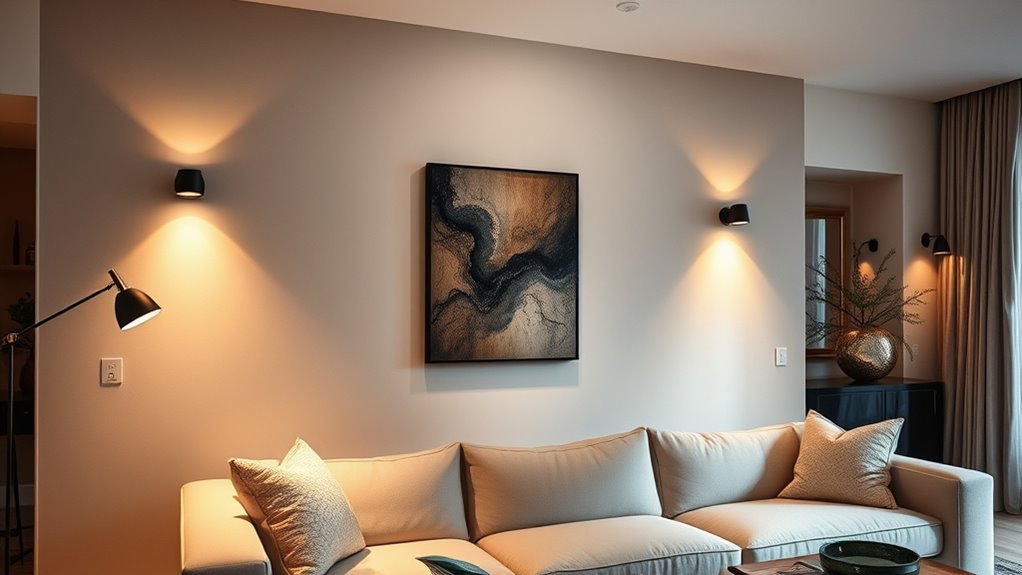
Choosing the right fixtures for your space involves selecting options that enhance your decor and meet your lighting needs. Look for light fixtures that match your style, like sleek spotlights for modern rooms or ornate sconces for traditional spaces. Adjustable fixtures, such as track lighting or directional spotlights, let you customize highlighting of artwork or architectural features. Dimmable lighting provides control over light intensity, creating the perfect ambiance. Opt for LED bulbs to ensure energy efficiency and longevity. Consider placement height and angle to maximize visual impact while avoiding glare or shadows.
| Fixture Type | Visual Impact |
|---|---|
| Adjustable track lights | Flexible highlighting and focus |
| Ornate wall sconces | Enhances decor with style |
| LED spotlight bulbs | Bright, energy-efficient illumination |
Tips for Creating a Cohesive Lighting Layer
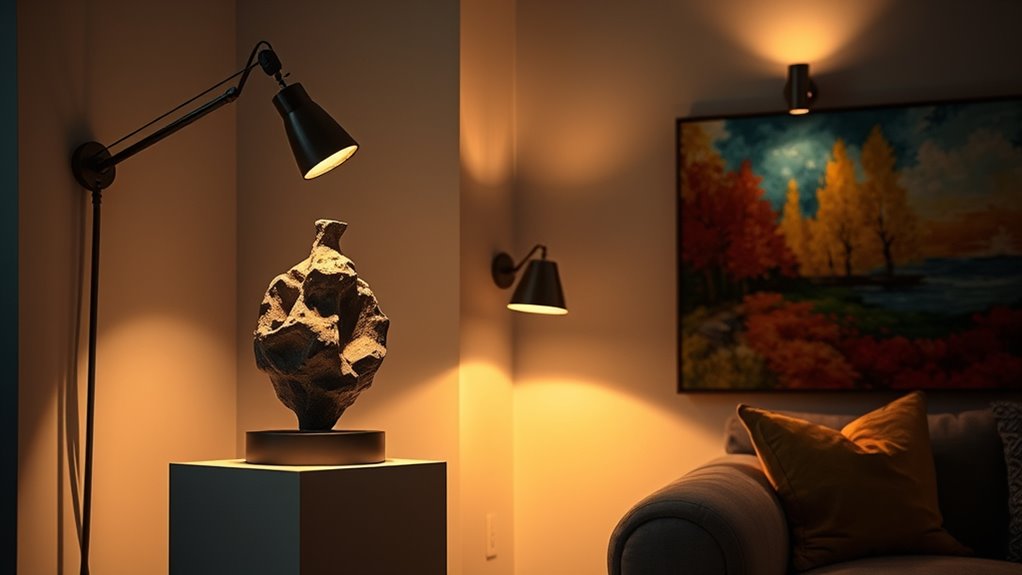
Creating a cohesive lighting layer involves thoughtfully combining different types of lighting to enhance both functionality and style. To achieve this, balance ambient, task, and accent lighting sources, adding depth and visual interest. Place accent lights strategically to highlight architectural features, artwork, or focal points without causing glare or shadows. Use dimmer switches to adjust the intensity of all lighting layers, ensuring a unified brightness throughout the space. Choose fixtures and bulbs that complement each other in style and color temperature, maintaining a consistent aesthetic. Remember, avoiding overcrowding with too many light sources is key—focus on a few well-placed accent lights to emphasize your design. A balanced lighting layer creates a harmonious, inviting atmosphere that highlights your home’s best features.
Enhancing Artwork, Plants, and Architectural Details

To make artwork, plants, and architectural details stand out, use targeted lighting that highlights their unique features. Proper placement creates depth and adds drama without overwhelming the space. Keep the lighting simple and strategic to draw focus naturally.
Highlighting Focal Pieces
Accent lighting can markedly enhance your home’s focal pieces, such as artwork, plants, and architectural details, by drawing attention and adding depth. To effectively highlight artwork, use picture lights or adjustable spotlights installed at a 30° angle, ensuring they’re close enough to create a subtle glow without glare. Incorporate warm light bulbs around 3000K to bring out reds and yellows, making your focal points feel cozy and inviting. Uplights or wall-mounted sconces can emphasize textured or three-dimensional details, adding visual interest. Remember, balance is key—don’t over-illuminate, as it can overpower the space.
- Position accent lighting near focal points for a gentle highlight
- Use adjustable spotlights for precise control
- Opt for warm light to enhance colors and ambiance
- Keep lighting subtle to avoid glare or shadows
Creating Depth and Drama
Enhancing your home’s artwork, plants, and architectural features with lighting adds depth and drama that transform the space. Use layered lighting with dimmable fixtures to create mood, emphasizing focus points. Highlight artwork with adjustable spotlights or track lighting, positioning accent lights at a 30° angle to minimize glare and bring out textures and colors. Uplights at floor level or wall sconces cast shadows, adding dimension and emphasizing architectural details and greenery. Avoid placing accent lights too close or bright, which can cause glare or overshadow the feature. Incorporate the following to maximize effect:
| Light Type | Placement | Purpose |
|---|---|---|
| Spotlights | Above artwork | Highlighting artwork |
| Uplights | Floor level | Creating depth and shadows |
| Accent lights | At 30° angle | Emphasizing textures and colors |
| Wall sconces | On walls near features | Adding shadows and dimension |
| Dimmable fixtures | Throughout | Adjusting mood and focus |
Incorporating Technology to Optimize Accent Lighting
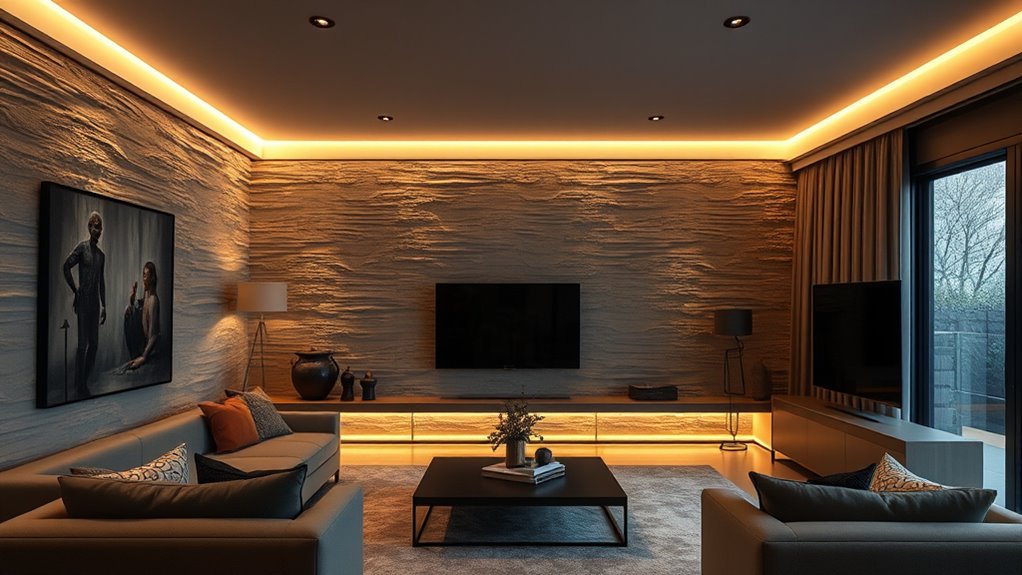
Incorporating technology into your accent lighting setup allows you to customize and control your ambiance with ease. With smart bulbs and dimmer switches, you can easily adjust brightness and tone to suit your mood or activity. Automated lighting systems and sensors help optimize placement and intensity based on occupancy and natural light, saving energy. Using smart plugs connected to accent lights enables remote control and seamless integration with home automation platforms like Alexa or Google Home. Color-changing LED bulbs with adjustable Kelvin temperatures give you dynamic options for seasonal or mood-based themes. This smart approach enhances both convenience and ambiance, giving you full control over your home’s aesthetic effortlessly.
- Control brightness and color with smart bulbs
- Use dimmer switches for adjustable ambiance
- Automate lighting based on occupancy and natural light
- Integrate with home automation systems for seamless control
Frequently Asked Questions
What Is the Golden Rule of Lighting?
The golden rule of lighting is to layer light sources—ambient, task, and accent—to create a balanced and appealing space. You should highlight specific features without overwhelming the room, ensuring even distribution and harmony. Mix different fixtures, adjust their placement, and choose bulbs that complement your room’s purpose. Position accent lights thoughtfully at varying heights and angles to add depth, focus, and a warm, inviting atmosphere.
How to Use Accent Lighting?
Think of accent lighting as your home’s jewelry, adding sparkle and focus. To use it effectively, target specific features like artwork or architectural details with spotlights or wall sconces at about 30° angles, avoiding glare. Keep the light brighter than the surroundings for contrast, and use dimmers to create a gentle glow. Combining different fixtures adds depth, turning your space into a carefully curated gallery of visual interest.
What Is the Rule of Thumb for Lighting?
When it comes to lighting, a good rule of thumb is to use 2-3 light sources per room. This mix creates balanced, layered illumination that highlights your space’s features. You should place accent lights at different heights—like sconces, table lamps, or ceiling fixtures—to add depth. Adjust the brightness to set the mood, making sure no single light dominates and the overall ambiance feels cohesive and inviting.
Do Light Fixtures Have to Match Throughout the House?
No, light fixtures don’t have to match throughout your house. Mixing styles can add visual interest and reflect your personality. Focus on maintaining consistency in finishes, like brushed nickel or matte black, to create harmony. Vary fixture sizes and shapes in different rooms for a unique ambiance, but keep a balanced look. Prioritize a cohesive aesthetic over perfect matching, making your home feel thoughtfully curated and personalized.
Conclusion
Think of accent lighting as the secret spice that turns a dull room into a mesmerizing masterpiece. When you place it thoughtfully, it highlights your favorite details and creates a warm, inviting glow. Avoid the common pitfalls, choose the right fixtures, and let technology be your guiding light. With a little planning, your home will shine with personality and charm, transforming every corner into a story worth telling.
